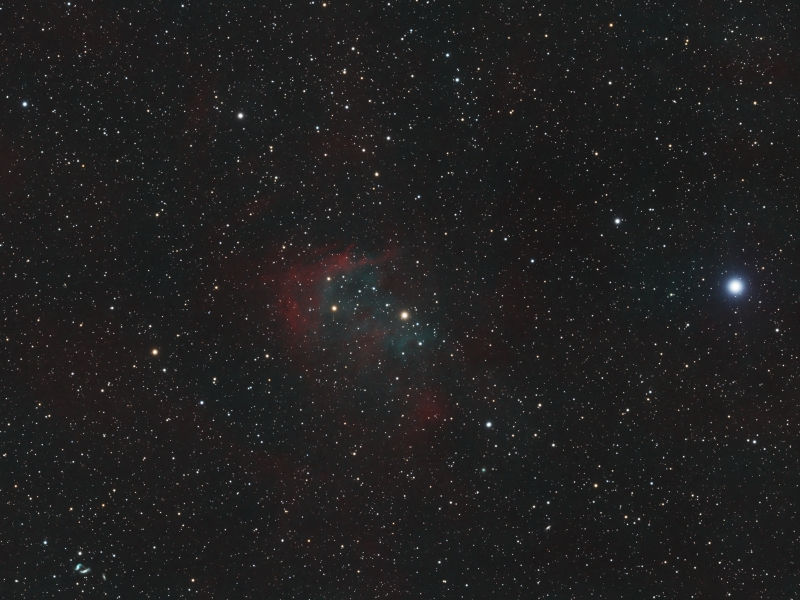Probable ISM Nebula Fr 2-30 in Andromeda
Published 12 Nov 21 (Update August 2023)
Full image field here: Un-cropped full resolution Cropped 2000x1500 pixel resolution
About this object
The above image is most likely the first deep color image of a probable ISM nebula in Andromeda called Fr 2-30. It was previously listed as a potential planetary nebula but recent studies (see link below) show its most likely a ISM nebula. It also goes by the designation PN G 126.7-15.4. Fr 2-30 is approximately 23 arc min in size and is extremely faint. In fact, in a normal RGB image, one would hardly know anything is there. This object was discovered by D. Frew and independently found with SDSS survey data by Yuan and Liu. It's also listed in the Hash planetary database. I was inspired to image this object after being contacted by Sakib Rasool, an amateur Astronomer from the UK who saw a previous image I had done of a faint confirmed planetary nebula. The image combines 28hrs of Ha exposures and OIII exposures taken through 5nm filters along with 5hrs of RGB exposures for star color. The data was collected during September and October of 2021 using a Stellarvue SVX 152T refractor and ASI 6200 mm pro camera. The image shows hydrogen (HII) as red and doubly ionized oxygen (OIII) as blue/green. RGB stars were added to the image from the RGV exposures. Whether this is an actual planetary nebula is unknown at this time as spectra has yet to be taken with professional class instruments. Maybe this image will entice the professionals to do so? UPDATE August 2023: A recent paper, published in the Monthly Notices of the Royal Astronomical Society, that I was involved with providing the image data, by Dr Howard Bond, Gregory R Zeimann and Klaus Werner determined that this object is most likely a ISM nebula and not a planetary nebula. You can read the paper here: https://academic.oup.com/mnras/article/523/3/3699/7188310?guestAccessKey=a8ef21a9-22f2-4d93-a2a3-5c4fd67ec750&utm_source=authortollfreelink&utm_campaign=mnras&utm_medium=email. It was extremly gratifying to know that my amateur image was used by Professional Astronomers to help explain this object.
There is also a neat cluster of galaxies in the lower left of the image. These are UGC 813, UGC 816 and Taffy 2. The two closest are thought to be interacting galaxies and the three lie 230 million light years distant.
The above image is most likely the first deep color image of a probable ISM nebula in Andromeda called Fr 2-30. It was previously listed as a potential planetary nebula but recent studies (see link below) show its most likely a ISM nebula. It also goes by the designation PN G 126.7-15.4. Fr 2-30 is approximately 23 arc min in size and is extremely faint. In fact, in a normal RGB image, one would hardly know anything is there. This object was discovered by D. Frew and independently found with SDSS survey data by Yuan and Liu. It's also listed in the Hash planetary database. I was inspired to image this object after being contacted by Sakib Rasool, an amateur Astronomer from the UK who saw a previous image I had done of a faint confirmed planetary nebula. The image combines 28hrs of Ha exposures and OIII exposures taken through 5nm filters along with 5hrs of RGB exposures for star color. The data was collected during September and October of 2021 using a Stellarvue SVX 152T refractor and ASI 6200 mm pro camera. The image shows hydrogen (HII) as red and doubly ionized oxygen (OIII) as blue/green. RGB stars were added to the image from the RGV exposures. Whether this is an actual planetary nebula is unknown at this time as spectra has yet to be taken with professional class instruments. Maybe this image will entice the professionals to do so? UPDATE August 2023: A recent paper, published in the Monthly Notices of the Royal Astronomical Society, that I was involved with providing the image data, by Dr Howard Bond, Gregory R Zeimann and Klaus Werner determined that this object is most likely a ISM nebula and not a planetary nebula. You can read the paper here: https://academic.oup.com/mnras/article/523/3/3699/7188310?guestAccessKey=a8ef21a9-22f2-4d93-a2a3-5c4fd67ec750&utm_source=authortollfreelink&utm_campaign=mnras&utm_medium=email. It was extremly gratifying to know that my amateur image was used by Professional Astronomers to help explain this object.
There is also a neat cluster of galaxies in the lower left of the image. These are UGC 813, UGC 816 and Taffy 2. The two closest are thought to be interacting galaxies and the three lie 230 million light years distant.
Image Details
- Optics : Stellarvue SVX 152T refractor @f8 1200mm FL
- Mount: Paramount MYT
- Camera: ZWO ASI6200
- Filters: Chroma 50mm RGB, 5nm OIII, Astrodon 50mm 5nm Ha
- Exposure (min): RGBHaOIII 100:100:100:840:840 33 hrs, 2x2 binning
- Automation Control: The Sky X, Voyager, PrimaluceLab Eagle 4
- Guiding: StarlightXpress Lodestar X2
- Processing Software: PixInsight,
- Location: Stark Bayou Observatory, Ocean Springs, MS
- Sky: Typical SQM 19.5 Bortle 5, Suburban
- Date: 10 Sep - 26 Oct 2021







